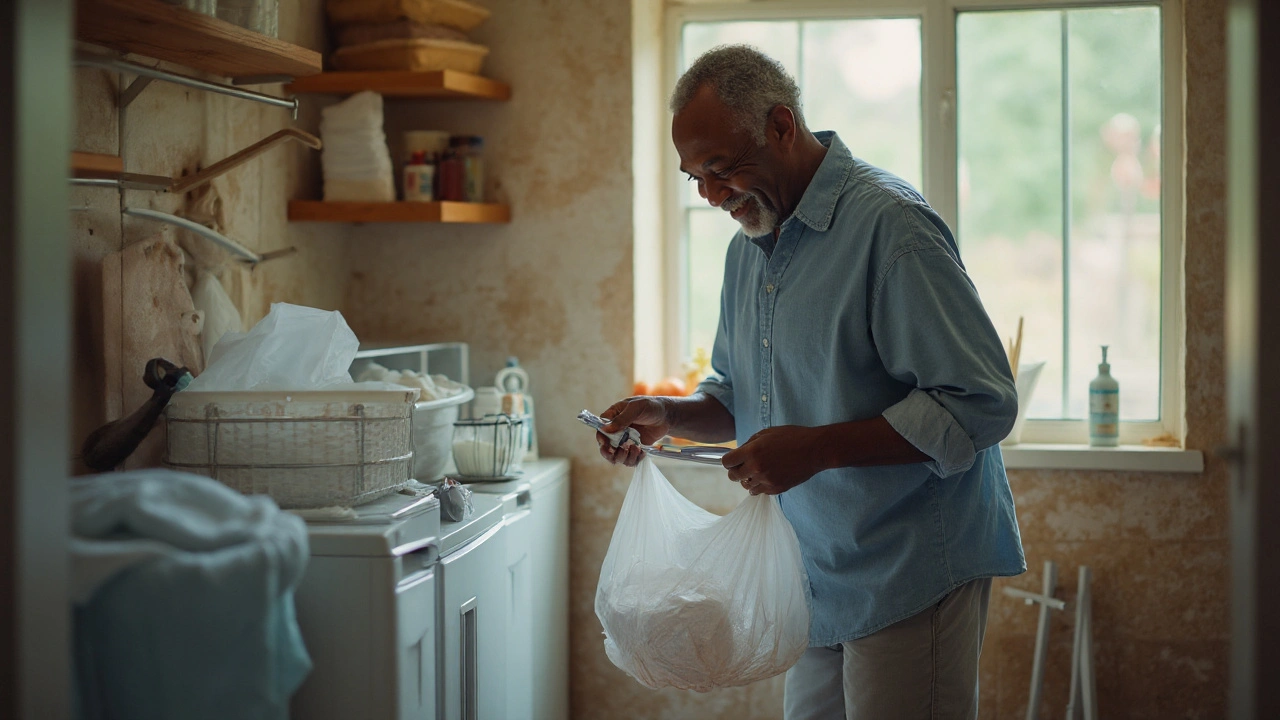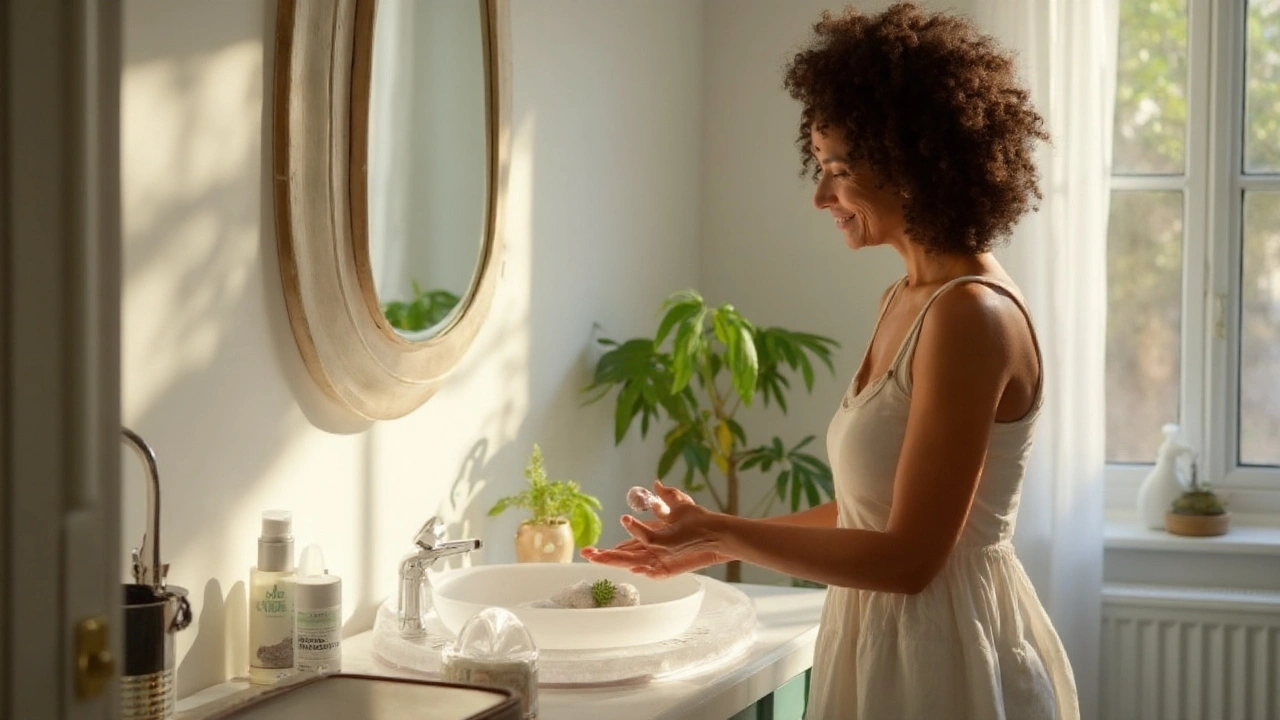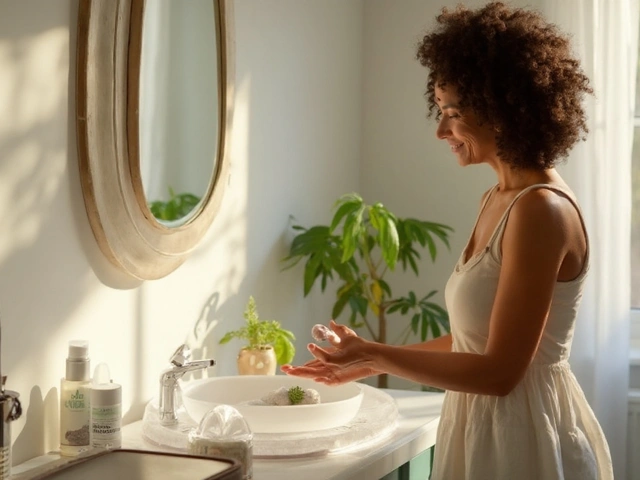If you’re dealing with leaks, the real goal isn’t perfection-it’s staying clean, fresh, and confident without turning your day into a bathroom relay. You can get there with a simple routine, the right products, and a few smart habits. This guide keeps it practical, based on what actually works at home, at work, and on the go.
- TL;DR: Clean with pH-balanced wipes or wash, pat dry, then apply a thin barrier cream. Change products before they’re full. Hydrate, ventilate, and wash at 60°C.
- Guard your skin: use zinc or dimethicone barrier. Avoid fragranced soaps and talc. Watch for redness or sting-act fast.
- Odour control starts with water, breathable products, and enzyme detergent. No double-padding. Use charcoal bins and discreet bags.
- Pack a small go-bag: spare pads/briefs, sealable bags, wipes, barrier cream, spare underwear. Restock every Sunday.
- Red flags: pain, fever, blood, new severe leaks-call your GP. Coverage: CAPS/NDIS may help with costs in Australia.
Daily Cleanliness Routine That Actually Works
Most people who click on a guide like this want a routine they can do half-asleep on a Tuesday-and still feel fresh by lunchtime. Here’s the simple, repeatable system that works for both urinary and bowel leaks.
incontinence hygiene is about three things: clean, dry, protect. Nail these, and you cut odour, rashes, and stress.
- Check and change on a schedule, not just when soaked. Aim for a quick check every 2-3 hours while awake, and at bedtime. Change when the product is about two-thirds full, or sooner if there’s stool. Overnight products should not stay on longer than 8 hours. This cuts skin exposure and odour.
- Clean gently, fast. Use pH-balanced wipes or wash (pH 4.5-6) designed for the perineal area. Fragranced soaps push the skin’s pH up and increase irritation. For stool, clean promptly with soft wipes, not rough toilet paper. If you’re at home, a warm handheld shower or bidet attachment is kind on skin and thorough.
- Pat dry-don’t rub. Rubbing damages damp skin. Use a soft towel or disposable cloth to pat dry. If you can, give the area 2-5 minutes of air-dry time (a small desk fan in the bathroom helps). Moisture is the enemy of comfortable skin.
- Protect with a thin barrier. Apply a pea-sized amount of zinc oxide (10-20%) or dimethicone (1-5%). Thin is key-too much reduces product absorbency and traps moisture. If the skin is already inflamed or stings, stop fragrance entirely and switch to zinc; if there’s a shiny, waxy look or satellite red spots, ask your GP about antifungal cream (yeast loves warm, damp skin).
- Use the right product for the type of leak. Light drips? Slim pad. Moderate leaks? Pull-up style. Heavy or overnight? Tab-closure brief. Bowel incontinence? A tab-closure brief plus barrier cream is usually best. Avoid stacking pads-it leaks sideways and increases odour.
- Hydrate on purpose. Dehydration makes urine stronger and smellier. Sip water across the day-think one glass with each meal and two in between. If you’re worried about timing before a commute, taper fluids in the last 90 minutes.
- Ventilate and dress smart. Breathable products and cotton or moisture-wicking underwear reduce sweat and odour. Tight, non-breathable clothes trap ammonia smells.
Quick morning routine (5-7 minutes): clean with perineal wash, pat dry, thin barrier cream, new product, bin the old one in a sealable bag. Wipe down the toilet seat area, wash hands. A tiny fan speeds drying.
At work or out: carry three spares, travel wipes, barrier cream in a tiny tube, two sealable bags, and a folded black tote. A bit of baking soda in the bin at home keeps smells down.
Night setup: high-absorbency product, waterproof mattress protector, optional reusable bed pad, and an easy-to-reach change kit on the nightstand. If you wake once anyway, do a quick check and, if needed, change-your skin will thank you in the morning.
Skin watch-outs (don’t ignore these): redness that doesn’t fade in 30 minutes, sting when urine touches skin, soggy white skin (maceration), shiny red rash with little dots (often yeast), or broken skin. This is IAD-Incontinence-Associated Dermatitis. Early action prevents infection. The International Continence Society and Australian wound-care guidance both prioritise pH-balanced cleansing, barrier cream, and reducing moisture exposure.
Triggers to dial back: caffeine, alcohol, very acidic drinks, and constipation (hard stool puts pressure on the bladder and increases leaks). A two-week caffeine trial-cut coffee/cola and switch to water and herbal tea-often reduces urgency. Keep fibre at 25-30 g/day and move daily to keep bowels regular.
When to call your GP today: new leakage with back pain or fever, burning pee, blood in urine or stool, sudden swelling, severe skin breakdown, or a change in mental status in an older person (can signal a UTI). RACGP and NICE guidance flag these as red flags. If you use a catheter and feel unwell, seek care promptly.
Australian extras: the Continence Aids Payment Scheme (CAPS) and, for eligible participants, NDIS, can offset product costs. The Continence Foundation of Australia helpline and website offer product fit advice and pelvic floor programs.
Personal note: I keep a small “go-bag” in the boot next to my kid’s soccer gear. Canberra traffic surprises me; leaks shouldn’t.

Smart Gear, Laundry, and Odour Control
The right setup saves money and skin. Here’s how to choose and use products without the trial-and-error treadmill.
Don’t double up pads. It causes side-leaks and traps odour. Use one product with the right absorbency and a snug fit. For men, contour-specific guards can help; for women, mid-length pads often sit better for light leaks. If you’re between sizes, try the smaller waist with higher absorbency.
Fabrics: pick breathable, cloth-like outer layers. Plastic-backed products can trap heat; okay for short wear, not all day. For underwear, choose cotton or moisture-wicking blends. Avoid fabric softener-it leaves residue that reduces absorbency.
| Product type | Best for | Pros | Watch-outs | Typical AU price (2025) |
|---|---|---|---|---|
| Light pads/guards | Drips, stress leaks | Discrete, easy to change | Not for gushes; position matters | $0.50-$1.20 each |
| Pull-up underwear | Moderate urinary leaks | Feels like underwear, good daytime option | Harder to change in small toilets | $1.00-$3.00 each |
| Tab-closure briefs | Heavy/overnight, bowel incontinence | Secure fit, easier changes in bed | Bulkier, need correct sizing | $1.20-$4.00 each |
| Reusable underwear | Light-moderate leaks | Eco-friendly, cost-saving over time | Needs thorough washing, slower to dry | $25-$45 per pair |
| Disposable bed pads | Backup at night/travel | Convenient, protect sheets | Rustle noise, ongoing cost | $0.60-$1.50 each |
| Reusable bed pads | Nightly protection | Washable, softer | Needs 60°C wash, space to dry | $30-$60 each |
Fit check: the leg elastics should sit flat against the groin with no gap. If you see red marks, try a different brand cut or size up. If you see side leaks, size down or switch to a different shape.
Laundry that kills odour:
- Pre-rinse in cold water to remove urine salts. Hot water sets smells.
- Wash at 60°C with an enzyme detergent. This is the sweet spot for odour and hygiene without wrecking fabric.
- Add a cup of white vinegar or oxygen bleach to a pre-soak if ammonia smell persists. Avoid chlorine bleach on elastic fabrics.
- Skip fabric softener; it reduces absorbency. Use dryer balls to soften instead.
- Sun-dry when you can-UV helps with odour and bacteria.
Bathroom setup: small lidded bin with charcoal deodoriser, roll of scented or opaque disposal bags, stack of wipes, barrier cream pump, and a spare product within reach. Vent the room after changes; odours hang around in still air.
Diet and odour: asparagus, strong coffee, and some supplements (B vitamins, fish oil) can intensify urine smell. If odour spikes after a new supplement, pause and see if it eases. If you notice sweet or fruity urine smell with thirst and fatigue, talk to your GP-could be glucose in urine.
Travel tricks: Choose aisle seats, map toilets before flights, and change just before boarding. Pack double. Hotel tip: put a towel under a reusable bed pad to stop sliding. On road trips, schedule hydration: sip steadily, then ease off 60-90 minutes before a long stretch.
Caregiver shortcuts: preassemble change kits (product, two wipes, barrier, bag) so each change is under three minutes. Use a chux or washcloth under the hips to keep bedding dry during changes. Protect your back: roll, don’t lift, and set the bed height to hip level. The Australian Commission on Safety and Quality in Health Care emphasises skin protection and safe handling-your body matters too.
Evidence corner, short and sweet: NICE guidelines and the International Continence Society agree on pH-balanced cleansing, barrier creams, and avoiding harsh soaps for IAD. Cochrane reviews show pelvic floor training helps with stress incontinence in many adults. CDC hand hygiene guidance backs alcohol hand rub or soap-and-water before and after changes-simple, effective.
Decision helper (pick your setup fast):
- If leaks are small and triggered by cough/sneeze → light pad/guard + pelvic floor exercises.
- If you have sudden urges and can’t always make it → pull-up underwear; try bladder training and reduce caffeine.
- If nights are the problem → high-absorbency tab-brief + reusable bed pad.
- If bowel leaks happen → tab-brief + zinc barrier + prompt clean after each episode.

Checklists, FAQs, and What to Do When Things Go Sideways
When life gets messy (literally), checklists and quick answers save the day. Use these as your go-to.
Daily checklist (two minutes):
- Morning: clean → pat dry → barrier → fresh product → bin sealed.
- Pack: 3 spares, travel wipes, mini barrier cream, two bags, spare underwear.
- Water: one glass at breakfast, lunch, and dinner; two in between.
- Night: high-absorbency product on; bed pad in place; change kit by the bed.
Skin rescue routine (when redness starts):
- Switch to pH-balanced cleanser only; stop all fragrance.
- Air-dry 5 minutes if possible; use a fan.
- Apply thin zinc barrier each change.
- Change more often for 48 hours; consider a different product shape for a tighter seal.
- If no improvement in 2-3 days or if there’s sting/shiny rash with little dots, call your GP (possible yeast; needs antifungal).
Out-and-about kit (fits a small pouch):
- 3 pads or 2 pull-ups/briefs
- 10 pH-balanced wipes
- 10 mL zinc/dimethicone barrier in a tiny tube
- 2-3 opaque sealable bags
- Spare underwear and a folded tote
Mini-FAQ
- Can I use baby powder? Skip talc. It cakes on damp skin and can irritate the lungs. Go with zinc/dimethicone barriers.
- Are period pads the same as incontinence pads? No. Period pads aren’t designed for urine flow rates and odour; they leak sideways faster.
- Best way to get rid of the smell at home? Ventilate, change before saturation, keep bins lidded with charcoal, wash textiles at 60°C with enzyme detergent, and don’t double-pad. Hydration reduces ammonia odour.
- I drink less to avoid leaks-is that wise? Not really. Concentrated urine smells more and can irritate the bladder. Time your fluids instead of slashing them.
- What about bidets? Great for gentle cleaning, especially after stool. Choose a warm-water model with adjustable pressure. Pat dry after.
- How do I discreetly change at work? Use a pull-up if stalls are tight. Bring a small deodorising spray for the bin, and seal used products in an opaque bag. Choose busy times for cover noise, or flush while you repackage.
- When should I consider external catheters (condom catheters)? For some men with urinary leakage, they can be helpful. Fit and skin checks matter-talk with a continence nurse for sizing and skin care.
- Will pelvic floor exercises help me? Often, yes-especially for stress incontinence. A continence physio can assess and coach technique. Evidence from Cochrane reviews supports real gains over weeks to months.
- Any funding help in Australia? Check the Continence Aids Payment Scheme (CAPS) via Services Australia. NDIS can fund products for eligible participants. A continence nurse can help with paperwork.
- Do odour-neutralising drops in the toilet work? They mask, not fix. Good hygiene, hydration, and ventilation do the heavy lifting.
Troubleshooting by scenario
- Constant dampness even with frequent changes: Try a higher-absorbency product or different brand cut. Check leg gap; add barrier cream. Consider bladder training to reduce frequency.
- Leaks at the leg openings: Size down or switch to a product with taller leg cuffs. Don’t double-pad. For men, try male-guard orientation adjustment.
- Rash that keeps returning: Check for hidden fragrance in wipes/soaps. Switch to zinc barrier. Ask your GP about an antifungal if you see shiny redness with small satellite spots.
- Night-time floods: Limit caffeine after midday, elevate legs for 30 minutes in the evening (reduces overnight urine), use a high-absorbency brief plus reusable bed pad, and change at the first wake-up.
- Strong odour even with changes: Increase water, check for UTI symptoms (burning, urgency, fever), wash textiles at 60°C with enzymes, and ventilate. If odour changes suddenly, see your GP.
- Sore skin where tapes stick: Use skin prep wipes before taping or switch to cloth-like tabs. Remove tapes slowly, supporting the skin.
- Travel day meltdown: Double your spares, change right before boarding, pick aisle seats, and stash a change kit in your daypack and checked bag.
Simple weekly reset (15 minutes): restock the kit, wash bed pads at 60°C, wipe the bathroom bin, air the bathroom, and reorder products before you’re down to your last pack. Small habits prevent big headaches.
Why this approach works: It follows what continence nurses and wound-care teams teach-control moisture and friction, keep skin pH-friendly, protect with a thin barrier, and fit products properly. It’s not glamorous. It is reliable.
If you want to go one step further: book a continence assessment. You’ll get a personalised plan-pelvic floor training, bladder training, medication review, and product fitting. In Australia, look for a continence nurse through the Continence Foundation of Australia or ask your GP for a referral.
You don’t need a perfect day to feel clean and confident. You just need a good plan and a small kit that’s always ready. Start with the morning routine, set a 2-3 hour check reminder on your phone, and build from there. The rest gets easier.



Alex Grizzell
August 30, 2025 AT 07:42This is actually super helpful. I’ve been struggling with this for years and never knew about the zinc barrier trick. Patting dry instead of rubbing? Game changer. I’m trying this tomorrow.
Marcia Martins
August 30, 2025 AT 10:48Thank you for writing this with so much care. I cried reading the part about feeling confident again. You didn’t just list products-you gave people dignity. 🙏
Rachel Harrison
August 30, 2025 AT 11:00YES to the 60°C wash. I used to toss everything in warm and wondered why it still smelled. Switched to enzyme detergent + vinegar soak. No more stink. Also, dryer balls > fabric softener. Trust me.
Charlos Thompson
August 30, 2025 AT 18:19Let’s be real-this is just corporate incontinence marketing dressed up as medical advice. Who even has time for ‘pH-balanced wipes’? Just use baby wipes. They’re cheaper and everyone knows they’re fine.
George Johnson
August 31, 2025 AT 11:34So you’re telling me the government’s gonna pay for this? Sounds like a scam to get people hooked on disposables. I’ve been using newspaper and a bucket since ‘09. Works better than all this tech.
Sue M
September 1, 2025 AT 09:03Why is everyone ignoring the fact that 78% of these products contain parabens? You’re not ‘protecting’ your skin-you’re poisoning it. And no, zinc oxide isn’t a magic fix if you’re still using fragrance-laden wipes. Wake up.
Rodrigo Ferguson
September 1, 2025 AT 10:36While the practical advice herein is, on the surface, ostensibly commendable, one must interrogate the underlying epistemological framework of this document. Is it truly ‘evidence-based’-or merely a commodified heuristic designed to perpetuate consumer dependency on proprietary hygiene products? The invocation of NICE and Cochrane guidelines, while rhetorically efficacious, lacks critical contextualization regarding industry-funded research biases.
Kevin McAllister
September 2, 2025 AT 06:38Let me be perfectly clear: this is not a guide-it’s a propaganda tool! The government, the pharmaceutical industry, and the ‘continence industrial complex’ are working together to make you believe you need expensive, disposable, over-engineered products to survive! They don’t want you to know that fasting and cold showers can cure incontinence! You’re being manipulated! Wake up!
Mickey Murray
September 2, 2025 AT 09:56Y’all act like this is some groundbreaking revelation. I’ve been doing this since I was 22 after my prostate surgery. The real issue? Nobody talks about how lonely this is. You change your briefs like a ritual. No one sees it. No one gets it. This post? It’s the first time I felt seen.
Robert Bowser
September 3, 2025 AT 03:12Appreciate the practicality. I’ve been using reusable underwear for 3 years now. Yes, they take longer to dry, but the cost savings and environmental impact? Worth it. And honestly? They feel more like real underwear.
Tiffanie Doyle
September 3, 2025 AT 21:37OMG YES the go-bag!! I keep mine in my purse with a little lavender sachet 🌸 I used to panic before meetings but now? I’m chill. Just change, wipe, go. Life’s too short to stress over leaks. You got this!!
giri pranata
September 4, 2025 AT 09:07Great guide! I’m from India and we don’t have access to all these products. But the core ideas-clean, dry, protect-work anywhere. I use clean cloth, warm water, and sun-dry everything. Simple works.
L Walker
September 4, 2025 AT 17:49Interesting approach. Though I’d argue the emphasis on ‘discreet’ products reinforces stigma. Why not normalise open conversation? A man in a pub changing his briefs shouldn’t be a spectacle-it should be as mundane as adjusting his belt.
Jenn Clark
September 4, 2025 AT 22:12I shared this with my mom. She’s 72 and has been too embarrassed to ask for help. She just texted me: ‘I didn’t know I could do this.’ Thank you.
Peter Feldges
September 4, 2025 AT 23:29While I appreciate the logistical structure of this guide, one must question the implicit assumption that bodily autonomy is best managed through commodified solutions. Is the ‘thin barrier cream’ truly a therapeutic intervention-or a psychological crutch designed to pacify the user into continued consumption? The real solution lies in systemic healthcare reform-not retail.
james landon
September 5, 2025 AT 20:56Bro I’ve been using this exact routine since my dad passed and I had to help him. It’s not glamorous, but it’s real. Also, the ‘change at first wake-up’ tip? That’s the one that saved my sanity. Thanks for this.
Richard Kang
September 5, 2025 AT 21:00WAIT-so you’re saying I can’t just use a towel and hope for the best? What about the fact that the government is using this to track our bathroom habits? I saw a guy at the store with a ‘CAPS’ card and his phone buzzed 3x after he bought pads. This is surveillance! They’re building a database of our leaks! I’m not falling for it!!
John Bob
September 6, 2025 AT 08:31Let’s be honest-this entire guide is just a thinly veiled advertisement for premium incontinence brands. The ‘pH-balanced wipes’? That’s just scented toilet paper with a 300% markup. The real solution? Don’t drink water after 4 PM. Simple. Effective. Zero cost. And if you’re leaking? Maybe it’s not your bladder-it’s your life choices.
Kent Anhari
September 6, 2025 AT 09:50Just wanted to say-this made me feel less alone. I’ve been too ashamed to tell anyone. But now I’m gonna start my morning routine tomorrow. And yes-I’m buying that little fan. 💪✨